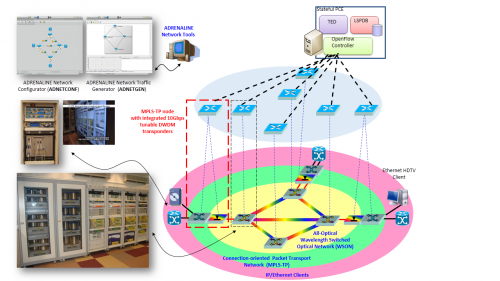New flex-grid system prevents optical network 'traffic jams'

Services like Google Maps use algorithms to determine the fastest route from point A to point B—even factoring in real-time traffic information as you travel to redirect you if, for example, a parade is blocking part of your route. Now, a team of researchers from Spain and Japan have achieved this kind of traffic control for the connections in optical networks by using a new dynamic network management system—and it does Google Maps one better. If necessary, the flexible-grid system can also redirect the traffic-congesting parade to another street (by re-arranging one or more existing connections), so you (a single new connection) wouldn't have to go out of your way to avoid gridlock.
Ramon Casellas, a research associate at the Catalonia Technological Center of Telecommunications (CTTC) near Barcelona, will describe the system developed by his team and colleagues at KDDI R&D Labs in Japan at the Optical Fiber Communication Conference and Exposition/National Fiber Optic Engineers Conference (OFC/NFOEC) March 17-21 in Anaheim, Calif. The research represents one of many OFC/NFOEC talks on future network capabilities made possible by Software-Defined Networking, a popular topic at this year's event.
This particular system design combines two elements: an OpenFlow controller and a so-called "stateful" path computation element (PCE). An OpenFlow controller uses a protocol that allows the behavior of a network device—regardless of its manufacturer—to be remotely configured and, Casellas says, "by extension, provides a way to operate a network using a logically centralized element that can see the network as a whole." This enables packets of data to navigate the path of switches on a network much more efficiently than with traditional routing protocols, as if there were multiple, but coordinated remote traffic controllers helping to guide the network.
A PCE, in simple terms, is a dedicated computer that finds network routes between endpoints. "The functions of a PCE are conceptually similar to Google Maps or GPS navigation systems," Casellas says.

A stateful PCE, he says, is smarter because it keeps track of and considers current connections to improve and dynamically correct the path computations for all of the connections in the network. Because the existing connections are stored in an internal database, advanced algorithms can use information about them to enhance network speed and efficiency. They do this by improving the optimization of the active connections as a whole instead of individually.
"The underlying idea," Casellas explains, "is that having extra information is helpful to improve the performance of the path computation, and thus the network. An active, stateful PCE also can affect the status of the active connections. For example, an active, stateful PCE is able to re-arrange active connections to allocate new ones."
Essentially, the system knows every connection on a network and what it is doing at any given time, with the ability to reroute those connections midstream based on new connections coming in to the network.
Casellas and his colleagues successfully tested their system by using it to dynamically control the optical spectrum in the fibers in a flexi-grid optical network. In such networks, he says, the intrinsic constraints of the optical technology—for example, caused by physical defects in the network—justify the deployment of PCEs.
"Combining a stateful PCE with OpenFlow provides an efficient solution for operating transport networks," says Casellas. "An OpenFlow controller and a stateful PCE have several functions in common but also complement each other, and it makes sense to integrate them. This allows a return on investment and reduces operational expenses and time-to-market."
More information: Casellas' presentation at OFC/NFOEC, titled "An Integrated Stateful PCE/OpenFlow controller for the Control and Management of Flexi-Grid Optical Networks," will take place Wednesday, March 20 at 3:45 p.m. in the Anaheim Convention Center.
Provided by Optical Society of America















